Sachsen is home to various birds, ranging from songbirds to waterfowl. Many of these birds are migratory, spending part of the year in Sachsen and the other part in other parts of the world.
Sachsen is also home to rare and endangered species, such as the Great Bustard and the White-tailed Eagle. The region also has many raptors, including eagles, hawks, and owls.
With its wide variety of habitats, including forests, wetlands, and open grasslands, Sachsen provides a rich and diverse environment for its birds.
24 Birds to Watch in Sachsen
Sachsen, or Saxony, is a landlocked state in eastern Germany that boasts a rich cultural and natural heritage. Among its many attractions are the beautiful landscapes of the Ore Mountains, the Elbe Sandstone Mountains, and the Saxon Switzerland National Park.
These areas are home to a diverse and colorful array of birds, some of which are rare or endangered in other parts of Europe.
Here are 24 birds that you can watch in Sachsen, either by visiting their habitats or by joining organized birdwatching tours.
1. Common Crane
The Common Crane is a species of bird belonging to the Gruidae family, commonly known as cranes. It is a medium-sized bird with a wingspan of up to 2.5 meters.
The Common Crane is the only crane species commonly found in Europe, besides the Demoiselle Crane and the Siberian Crane, which are only regular visitors to the far eastern regions of the continent.
It is a migratory species, traveling south in the winter and north in the summer months to breed. They have a variety of habitats, ranging from wetlands to dry grasslands. They feed on various food, including grains, aquatic plants, insects, and small vertebrates.
The Common Crane is a social species, forming large flocks during migration and when foraging. They communicate using a variety of calls and postures. The Common Crane is a species of conservation concern due to habitat loss, degradation, and illegal hunting.
Conservation efforts are underway to protect this species and its habitats.
| Kingdom | Animalia |
| Phylum | Chordata |
| Class | Aves |
| Order | Gruiformes |
| Family | Gruidae |
| Genus | Grus |
| Species | G. grus |
2. Greylag Goose
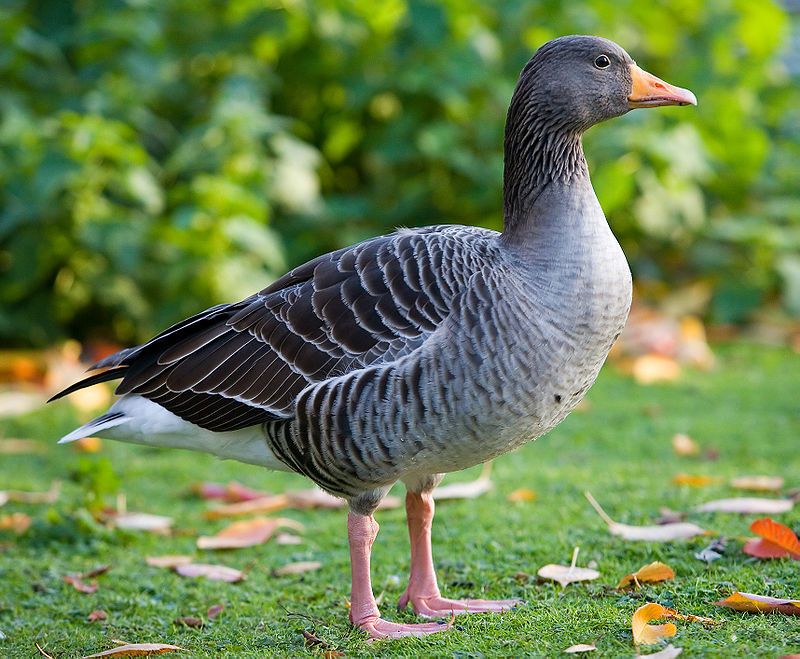
The Greylag Goose is a member of the waterfowl family Anatidae and is the type species of the genus Anser. It is a large goose species, typically with a length of between 80 and 110 centimeters and a wingspan of between 130 and 170 centimeters.
Its plumage is mottled and barred, with grey and white tones, an orange beak, and pink legs. Greylag Geese typically inhabit wetlands and open areas, feeding on grasses, grains, and insects. They are also known to eat small fish and crustaceans.
They tend to form flocks of up to 50 birds and migrate southward in the winter to avoid colder climates. These geese are also known to breed in colonies, often near coastal areas, where they can find food and shelter.
| Kingdom | Animalia |
| Phylum | Chordata |
| Class | Aves |
| Order | Anseriformes |
| Family | Anatidae |
| Genus | Anser |
| Species | A. anser |
3. Great Cormorant
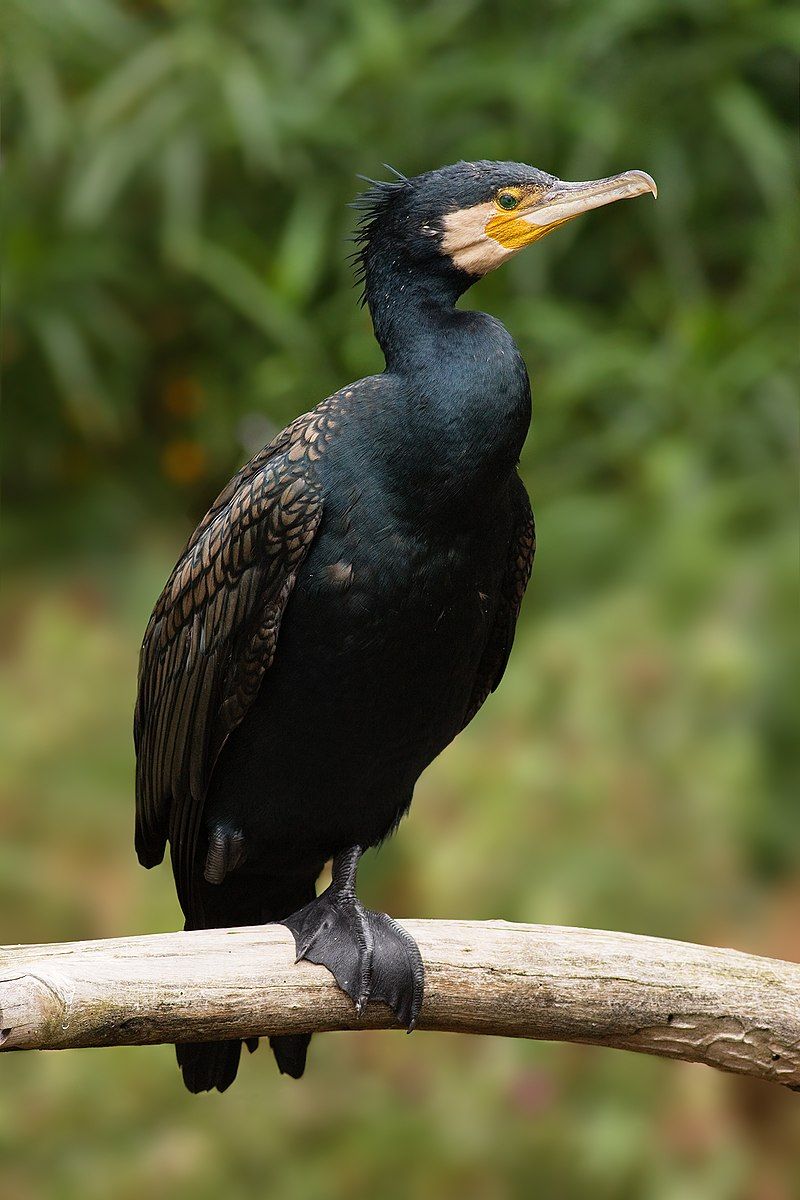
The great cormorant, also known as the black shag or kawau in New Zealand, is a widely distributed member of the cormorant family of seabirds.
Across the Northern Hemisphere, it is known as the great black cormorant; in Australia, it is known as the black cormorant; and in India, it is known as the large cormorant.
This species of cormorant is found in many countries around the world and can be found near both freshwater and saltwater habitats. The great cormorant is a medium-sized bird with a wingspan of up to 1.2 meters (4 feet) and a body length of up to 65 cm (25.5 in).
Its body is typically black or dark brown, with a white patch at the base of its neck. Its head is usually black, with a yellow-orange patch on its throat.
Its bill is long and pointed, and its legs are short and yellow. The great cormorant feeds mainly on fish but eats crustaceans and mollusks. It dives into the water to catch its prey, and its feathers are adapted to help it stay dry and warm.
It can stay underwater for up to 30 seconds at a time. The great cormorant is a social bird, and it can often be seen in large flocks, flying together in formation.
It is also known for its loud calls, which can be heard for miles. The great cormorant has a wide range and is found in countries such as the United Kingdom, Japan, Canada, the United States, and New Zealand.
Its population is stable, and it is not currently threatened with extinction.
| Kingdom | Animalia |
| Phylum | Chordata |
| Class | Aves |
| Order | Suliformes |
| Family | Phalacrocoracidae |
| Genus | Phalacrocorax |
| Species | P. carbo |
4. Wood Pigeon
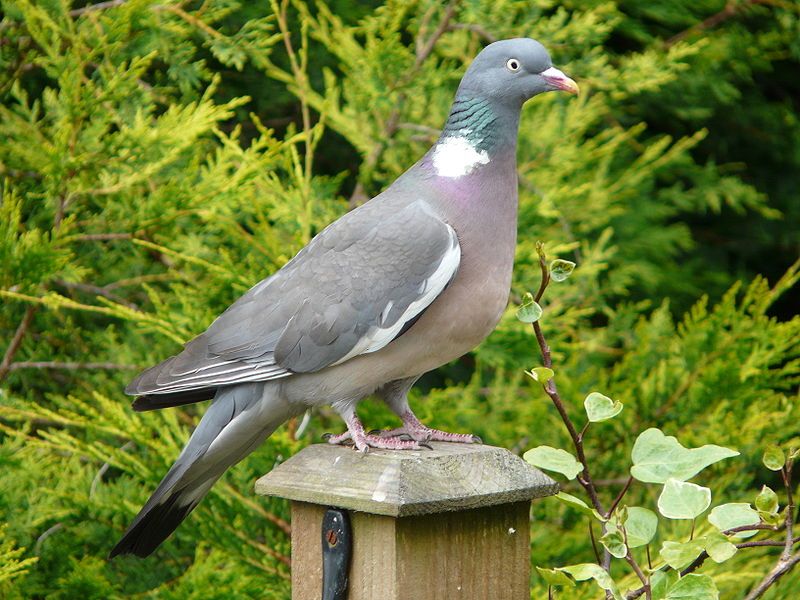
The standard wood pigeon is a species of dove and pigeon found in the western Palearctic region of the world. It is a large bird belonging to the genus Columba, which contains other closely related species, such as the rock dove.
This bird is also known simply as the wood pigeon and is easily identified by its distinct white patches on its wings and its cooing sound. Its diet consists mainly of seeds and grains but will also eat fruits, buds, and some insects.
It is an adaptable species that is found in a wide variety of habitats, including woodlands, meadows, and urban areas. It builds its nests in trees or shrubs; its eggs are white with brown and purple markings.
Wood pigeons play an essential role in the ecosystem, as they are a food source for many predators and disperse the seeds of plants in their droppings, helping to spread them throughout their range.
| Kingdom | Animalia |
| Phylum | Chordata |
| Class | Aves |
| Order | Columbiformes |
| Family | Columbidae |
| Genus | Columba |
| Species | C. palumbus |
5. Eurasian Blackbird
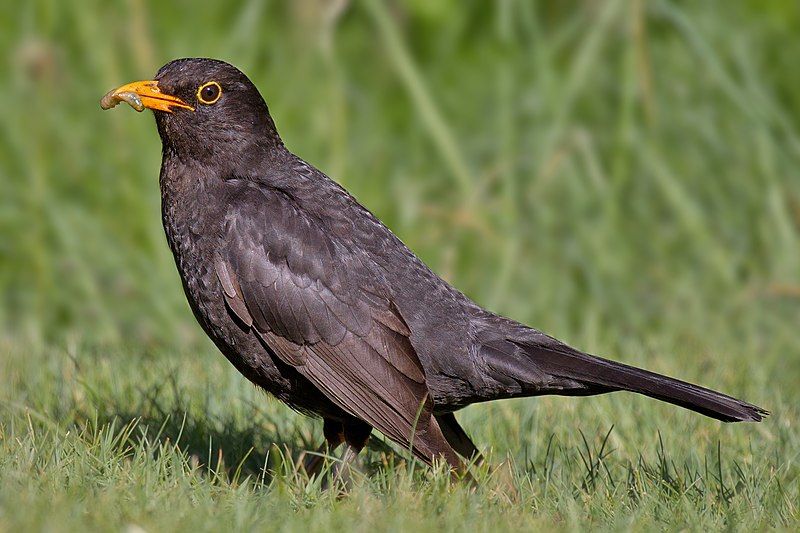
The common blackbird is a species of true thrush, also known by its scientific name of Turdus merula. It is native to Europe, Asiatic Russia, and North Africa and has since been introduced to Australia and New Zealand by humans.
They can be identified by their glossy black feathers and yellow beak, often found in gardens and parks. They are omnivorous, feeding on fruits, insects, and worms. The common blackbird is a social bird, often found in small groups or flocks.
They are widely considered beneficial to humans due to their insectivorous habits, which help keep insect pests under control.
They are also popularly kept as pets due to their attractive appearance and song. The common blackbird is an iconic literary, art, and music species.
It is often associated with themes of freedom and nature, and its bold song is usually used to represent the dawning of a new day. Bird watchers and other nature lovers alike widely appreciate it.
| Kingdom | Animalia |
| Phylum | Chordata |
| Class | Aves |
| Order | Passeriformes |
| Family | Turdidae |
| Genus | Turdus |
| Species | T. merula |
6. Red Kite
The red kite is a bird of prey species in the Accipitridae family, a large family of diurnal raptors that includes eagles, buzzards, and harriers. Red kites are considered to be a medium-large birds of prey, and they are mainly found in Europe.
However, in the past, they also used to breed in western Asia and northwest Africa. This bird species has a wingspan of up to 179 cm and various plumage colors depending on the region.
They feed mainly on small mammals, such as voles, reptiles, amphibians, insects, and carrion. They build large nests in trees, and they nest in colonies.
Red kites are endangered due to their declining population and are protected under various European laws.
| Kingdom | Animalia |
| Phylum | Chordata |
| Class | Aves |
| Order | Accipitriformes |
| Family | Accipitridae |
| Genus | Milvus |
| Species | M. milvus |
7. Great Crested Grebe
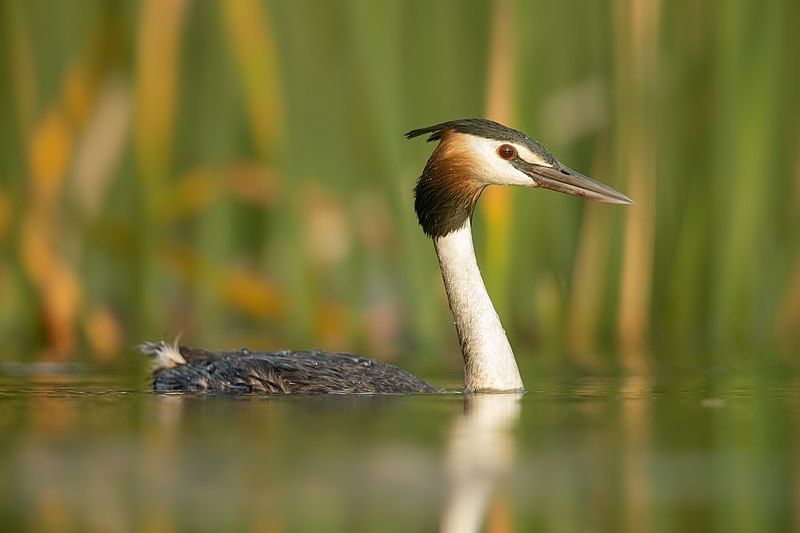
The great crested grebe is a medium-sized water bird that belongs to the Podicipedidae family of grebes. It is easily recognizable by its distinctive black-and-white plumage, long, thin neck, and orange-brown eyes.
The great crested grebe is found in many parts of the world, including North America, Europe, and Asia. The great crested grebe is well known for its elaborate courtship display, an integral part of its mating ritual.
During the display, the male and female grebes face each other and perform various movements and vocalizations, such as head-shaking and head-nodding. They may also engage in a mutual foot-dipping ritual in which the grebes synchronize with their feet in the water.
This display is believed to help bond the pair and strengthen their relationship. The great crested grebe is an excellent swimmer, diver, and a highly efficient and prodigious hunter. It primarily feeds on fish, small amphibians, and aquatic insects.
The birds nest on the water’s edge, and the female typically lays three to four eggs. Both parents help to incubate and care for the young.
The great crested grebe is an impressive species of water bird, well known for its elaborate courtship display and striking black-and-white plumage. It is an integral part of many aquatic ecosystems and a game bird for hunters.
| Kingdom | Animalia |
| Phylum | Chordata |
| Class | Aves |
| Order | Podicipediformes |
| Family | Podicipedidae |
| Genus | Podiceps |
| Species | P. cristatus |
8. Common Cuckoo
The common cuckoo is a type of bird belonging to the Cuculiformes order, a group of species consisting of roadrunners, anis, and coucals. This bird is found all across the northern hemisphere, with its range extending to Europe and Asia during the summer months.
During the winter, it migrates south and is commonly found in Africa.
The common cuckoo is a migratory bird, and its migratory habits are primarily determined by the seasons and the availability of food sources. The common cuckoo is a relatively large bird, typically reaching up to 16 inches long.
Its feathers are usually grayish-brown, and its head is adorned with tiny white feathers. Its eyes are dark, and its beak is hooked.
Its feet are long and robust, enabling it to perch on branches for long periods. The common cuckoo is an omnivorous bird that eats plant and animal matter.
Its diet comprises fruits, seeds, insects, and small animals such as lizards, frogs, and even small birds.
It’s also known to scavenge for carrion. The common cuckoo can be heard calling out its signature two-note call in the warmer months, usually from April until July. This call is often heard during the early morning hours and can be heard from up to a mile away.
Other birds, such as the Eurasian skylark, often imitate the call. The common cuckoo is a large and widespread bird that belongs to the Cuculiformes order.
It is a migratory species, traveling between Europe and Asia in the summer and Africa in the winter for food. It is an omnivore, eating plant and animal matter, and its distinctive two-note call can be heard from miles away.
| Kingdom | Animalia |
| Phylum | Chordata |
| Class | Aves |
| Order | Cuculiformes |
| Family | Cuculidae |
| Genus | Cuculus |
| Species | C. canorus |
9. Grey Heron
The grey heron is a majestic wading bird of the heron family Ardeidae and is widely distributed throughout temperate climates in Europe, Asia, and Africa. It is a resident species in much of its range, meaning it lives and breeds in the exact location year-round.
However, in the northernmost parts of its range, the grey heron population migrates south during autumn. This is thought to be due to the colder, harsher winter conditions and the need to find new habitats with abundant food sources.
The grey heron has a long, slender body and long legs, which help it wade through shallow water to find food. Its diet mainly consists of small fish, frogs, insects, and mammals.
Its grey feathers help it camouflage in its marshy environments, and its sharp eyesight helps it spot its prey from a distance. The grey heron can be seen wading through shallow waters and found in open grassland, wetlands, and other marshy areas.
Despite its elegant appearance, it is a fierce predator and can attack its prey with a powerful jab from its long beak. With its ability to survive in various habitats, its wide range, and impressive hunting skills, the grey heron is a vital part of the ecosystem.
| Kingdom | Animalia |
| Phylum | Chordata |
| Class | Aves |
| Order | Pelecaniformes |
| Family | Ardeidae |
| Genus | Ardea |
| Species | A. cinerea |
10. Great Tit
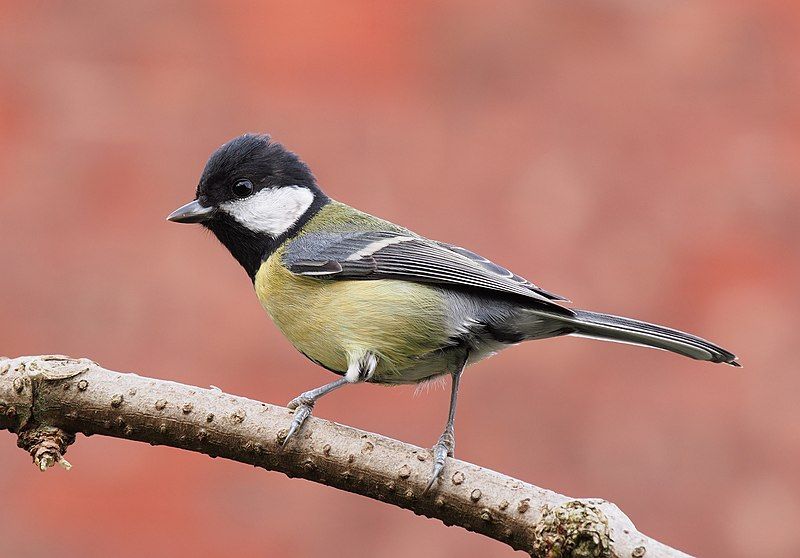
The great tit is a species of bird that belongs to the Paridae family, which is also known as the tit family. It is found in various habitats throughout Europe, the Middle East, Central Asia, and the Amur River.
This species is quite common in these areas and is known for its distinctive plumage. The great tit has a gray head, black chin, white cheeks, and a yellow breast. Its wings are black with white spots, and its tail is black and white.
The great tit is primarily a seed-eating bird, but it will also feed on insects and other invertebrates. This species is also known for its vocalizations, consisting of various chirps and whistles. The great tit is a social species and is often seen in small flocks.
Its nest is usually constructed high in a tree or other tall structure, and it is often used for many years with the same pair of birds.
| Kingdom | Animalia |
| Phylum | Chordata |
| Class | Aves |
| Order | Passeriformes |
| Family | Paridae |
| Genus | Parus |
| Species | P. major |
11. Black-Headed Gull
The black-headed gull is a small gull found in various parts of the Palearctic region, such as Europe and coastal eastern Canada. These gulls usually migrate south during the winter season, but some remain in the more temperate areas of Europe.
The species is highly adaptable and can live in various habitats, from coastal areas to farmland and even urban areas. They feed on multiple items, such as fish, crustaceans, insects, mollusks, and even garbage.
During breeding, they form large colonies to nest and raise their young. The black-headed gull is a common sight in many parts of Europe and is known for its distinctive black head and white body.
It is a famous bird for birdwatchers and other people interested in nature and wildlife.
| Kingdom | Animalia |
| Phylum | Chordata |
| Class | Aves |
| Order | Charadriiformes |
| Family | Laridae |
| Genus | Chroicocephalus |
| Species | C. ridibundus |
12. Whooper Swan
The whooper swan is a large bird native to the northern hemisphere. It is arguably the most recognizable species of swan due to its white plumage, long neck, and black bill. It is also known as the common swan and is the Eurasian counterpart of the North American trumpeter swan.
This species is the type species for the genus Cygnus, which includes all species of swans worldwide. The whooper swan is a migratory bird, spending its summers in Scandinavia and Russia and winters in the United Kingdom and other parts of Europe.
It feeds mainly on aquatic vegetation, small fish, and invertebrates and is a famous sight on lakes and rivers. The whooper swan is a crucial culturally and ecologically relevant species, as it is a keystone species in the wetland ecosystems it inhabits.
| Kingdom | Animalia |
| Phylum | Chordata |
| Class | Aves |
| Order | Anseriformes |
| Family | Anatidae |
| Genus | Cygnus |
| Species | C. cygnus |
13. Mute Swan
The mute swan is a species of swan that is part of the Anatidae family, commonly called waterfowl. This species of swan is native to large parts of Europe and Siberia, as well as the far north of Africa.
It is easily identified by its all-white plumage, long curved neck, and orange beak. This beautiful bird is a famous sight in many parks and gardens and is also known as the royal bird in many cultures.
Mute swans are generally solitary creatures, but they can be seen in pairs during the breeding season. They are known to be very territorial and will aggressively defend their space from any intruders.
They feed mainly on aquatic vegetation and small fish, which they forage for in shallow water.
To communicate, they use a variety of vocalizations, including hissing, snorting, and grunting. Mute swans have been kept in captivity for centuries and are often seen in parks and gardens today. They are also popular in zoos, where they are kept as part of educational exhibits.
Unfortunately, they are also hunted for sport, and their feathers are used for decorations and clothing. Overall, the mute swan is an iconic bird with a beautiful appearance and strong presence.
Its distinct features have made it a favorite of many people worldwide, making it a symbol of grace and beauty.
| Kingdom | Animalia |
| Phylum | Chordata |
| Class | Aves |
| Order | Anseriformes |
| Family | Anatidae |
| Genus | Cygnus |
| Species | C. olor |
14. Ruddy Shelduck
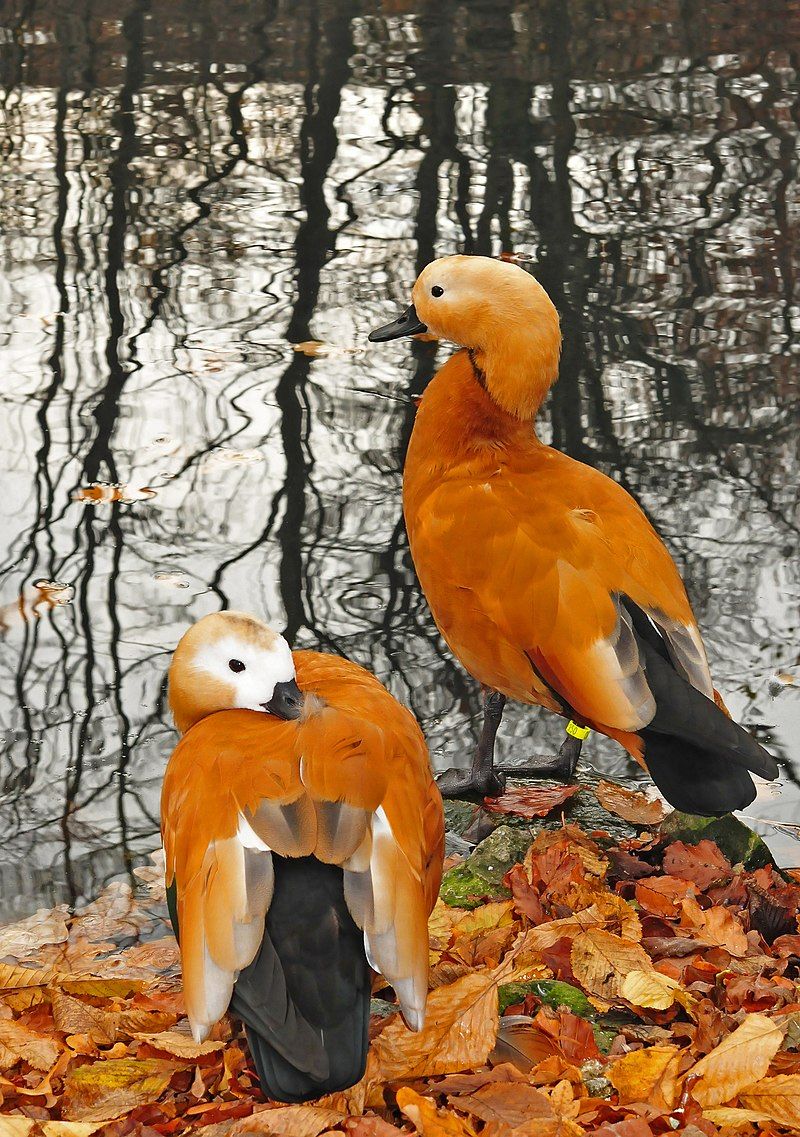
The ruddy shelduck, or Brahminy duck as it is known in India, is a beautiful member of the Anatidae family. It is a medium-sized waterfowl measuring 58 to 70 cm long with a 110 to 135 cm wingspan.
Its plumage has shades of brown, red, and white markings on the head, neck, and wings. The tail is long and has a black tip.
The bill is orange-red, and the legs and feet are a deep pink. The ruddy shelduck is an omnivorous species that feeds on various food sources. Its diet comprises beetles, mollusks, aquatic insects, plant material, grain, and small fish.
It is a gregarious species that often feeds in large groups. It is also very territorial and will defend its area vigorously against intruders. The ruddy shelduck is found in the wetlands of temperate Asia and is a migratory species.
It spends the winter in India, Pakistan, Iran, and Central Asia and the summer in Siberia and northern China.
It nests in trees or on the ground and lays 8-12 eggs. The ruddy shelduck is an essential species for the environment, as it plays a vital role in controlling aquatic vegetation.
It is also hunted for its feathers and meat and is a famous game bird in some of its range. Despite this, its population is stable, and the species is not listed as threatened.
| Kingdom | Animalia |
| Phylum | Chordata |
| Class | Aves |
| Order | Anseriformes |
| Family | Anatidae |
| Genus | Tadorna |
| Species | T. ferruginea |
15. Grebes
Grebes are a type of aquatic bird from the order Podicipediformes. They can be found in freshwater habitats worldwide, though some species are known to migrate to marine habitats during winter.
Grebes are capable of flight, but a few species are flightless, most commonly found in still, undisturbed lakes. Grebes have specially adapted to their aquatic habitats, possessing webbed feet and waterproof feathers.
The feathers help them stay afloat and provide insulation against the cold. They are also excellent swimmers, able to dive deep underwater in search of food. Grebes typically feed on fish, amphibians, crustaceans, and aquatic plants.
They usually form monogamous pairs and breed in freshwater marshes and lakes.
| Kingdom | Animalia |
| Phylum | Chordata |
| Class | Aves |
| Clade | Mirandornithes |
| Order | Podicipediformes |
| Family | Podicipedidae |
16. European White Stork
The white stork is a species of large bird from the Ciconiidae family, also known as the stork family. Its plumage is mainly white, with black feathers covering its wings.
Adult white storks are particularly distinctive in their appearance, with long red legs and a long, pointed red beak. They have an average length of 100-115 cm from the tip of their beak to the end of their tail, with a wingspan of 155-215 cm.
These birds are majestic creatures and are a common sight in many parts of the world. White storks are found in parts of Africa, Europe, and Asia.
In Africa, they are commonly found in the southern parts of the continent, while in Europe, they are mainly concentrated in the Mediterranean region. They have also been spotted in other parts of Europe, including the United Kingdom.
In Asia, they are found mainly in the south and southeast and have been seen in China, Japan, and India. White storks are omnivorous and feed on a variety of items.
They primarily eat small fish, frogs, and other aquatic creatures but also forage for plant material, insects, and other small animals. They often feed in flocks and utilize their long beaks to reach into shallow water and pull out food.
White storks are also known for their impressive migratory abilities. They leave their breeding grounds in the spring and migrate south to spend the winter in warmer climates.
Their migration routes have been well documented and are known to travel up to 6,000 km in a single journey. The white stork is a remarkable bird that people worldwide have admired for centuries.
They are an integral part of many ecosystems and are essential for dispersing nutrients and maintaining balance.
| Kingdom | Animalia |
| Phylum | Chordata |
| Class | Aves |
| Order | Ciconiiformes |
| Family | Ciconiidae |
| Genus | Ciconia |
| Species | C. ciconia |
17. Black Redstart
The black redstart is a small bird belonging to the genus Phoenicurus. It is a passerine bird which falls under the Old World flycatcher family. It is closely related to birds like thrush, formerly classified as members of the thrush family.
It was given various names, such as Tithys Redstart, blackstart, and black redtail. However, these names are no longer in use. The black redstart is known for its distinctive black feathers and reddish tail.
It is a small and agile bird found in various parts of the world. It has a varied diet and feeds on insects, fruits, and other small animals. It is known to be a shy bird and is elusive.
| Kingdom | Animalia |
| Phylum | Chordata |
| Class | Aves |
| Order | Passeriformes |
| Family | Muscicapidae |
| Genus | Phoenicurus |
| Species | P. ochruros |
18. Common Pochard
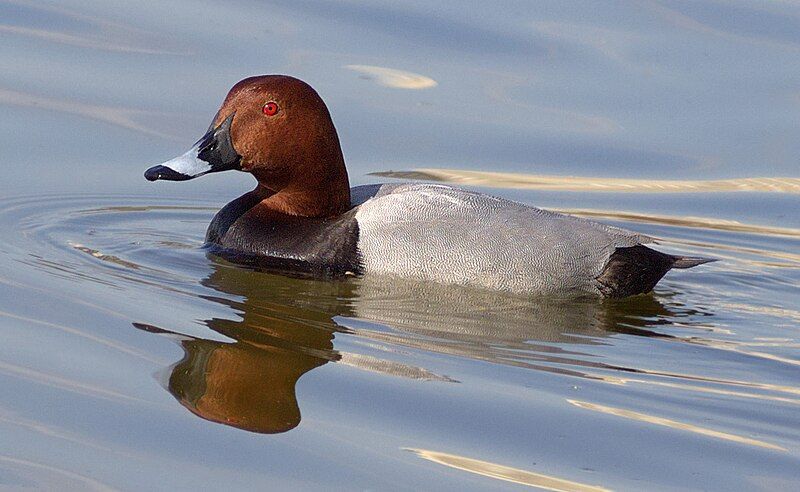
The common pochard is a species of diving duck that is considered to be medium-sized. Its scientific name, Aythya ferina, combines two words with exciting origins.
The first part of the name, Aythya, is derived from the Greek word Lithuania, an unidentified seabird mentioned by famous authors such as Hesychius and Aristotle.
The second part of the name, ferina, is derived from the Latin word ferina, which translates to “wild game” and comes from fetus, which means “wild.” This name, Aythya ferina, accurately reflects the common pochard’s wild nature.
| Kingdom | Animalia |
| Phylum | Chordata |
| Class | Aves |
| Order | Anseriformes |
| Family | Anatidae |
| Genus | Aythya |
| Species | A. ferina |
19. Tufted Duck
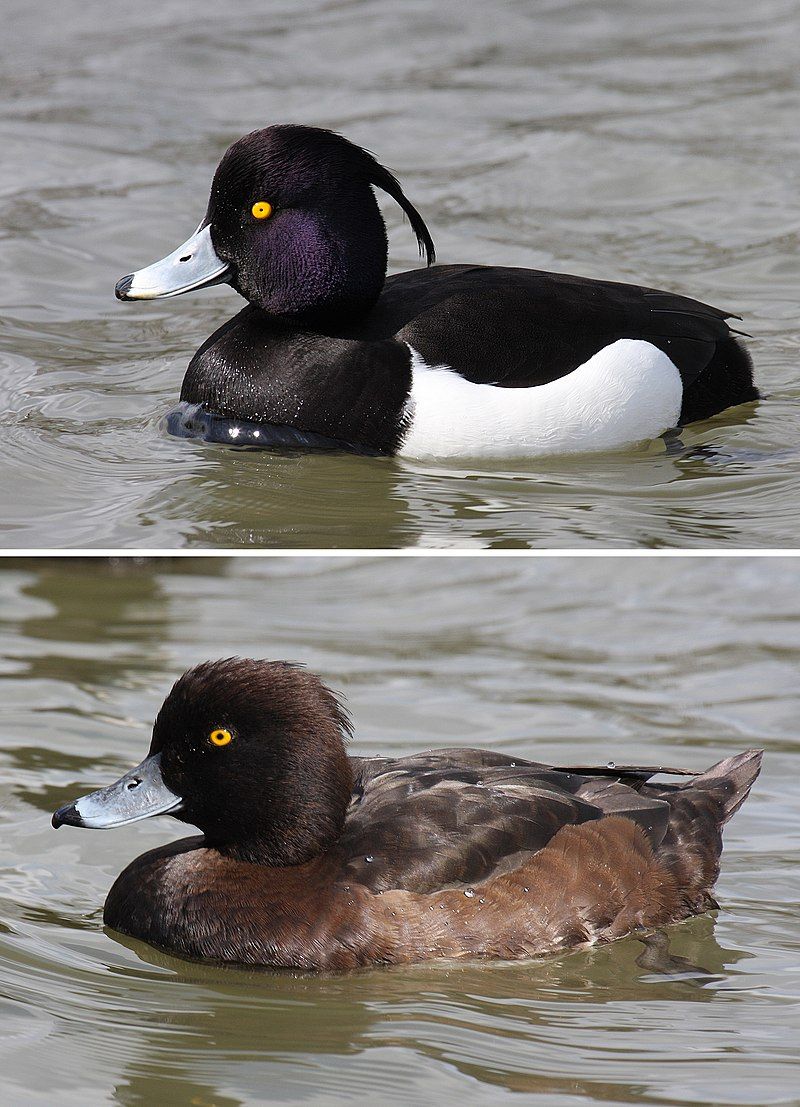
The tufted duck, also known as the tufted pochard, is a small species of diving duck across Northern Eurasia. It is estimated that there are close to one million tufted ducks across the region. The scientific name of the tufted duck is derived from two sources.
The first source is Ancient Greek, the word Lithuania, an unidentified seabird mentioned by authors such as Hesychius and Aristotle.
The second source is the Latin words fuligo, meaning “soot,” and gula, meaning “throat.” The tufted duck is primarily black or dark brown and has a white patch on its head.
It is also known for its tuft of feathers on the back of its head, a distinguishing feature of this species. The tufted duck spends most of its time in shallow water, feeding on aquatic plants and invertebrates.
During the winter, the tufted duck will migrate south for warmer climates. The tufted duck is an essential species in many areas, as it is a vital food source for human consumption.
In addition, the tufted duck is also an essential species for conservation, as it is a crucial indicator of the health of wetland habitats. Preserving the tufted duck is critical to the environment’s overall health.
| Kingdom | Animalia |
| Phylum | Chordata |
| Class | Aves |
| Order | Anseriformes |
| Family | Anatidae |
| Genus | Aythya |
| Species | A. fuligula |
20. Common Moorhen
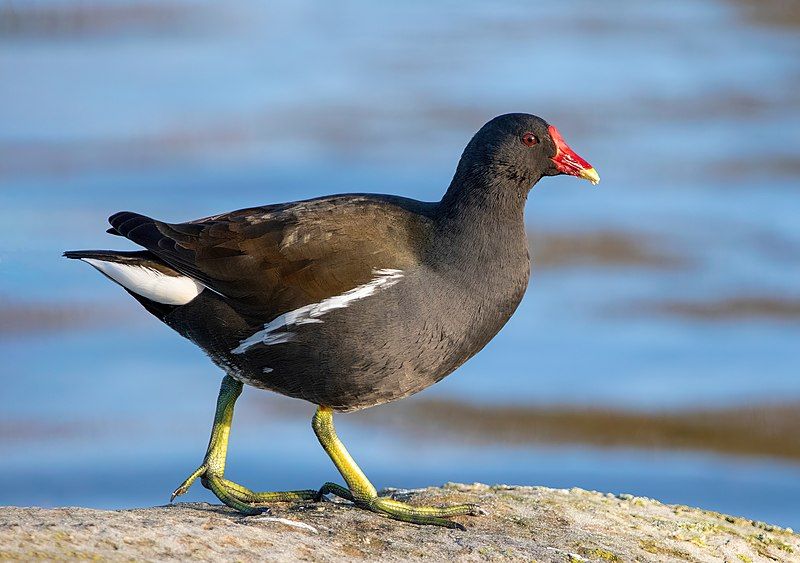
The Common Moorhen, also known as Waterhen or Swamp Chicken, is a bird species in the Rail family.
It is found across much of the Old World and is common in many areas. The Common Moorhen has a preference for wetland habitats that are densely vegetated, such as marshes, ponds, canals, and other wetlands.
It is so well adapted to these areas that it is often seen foraging for food in shallow water or perched on floating vegetation.
It is also known for its distinctive black and white plumage and long toes, which help it to navigate its aquatic home. The Common Moorhen is an omnivore, feeding on various plant material and small marine animals.
It nests in dense vegetation near its feeding grounds and is easily identified by its loud call. In conclusion, the Common Moorhen is a widespread species of bird that is well-adapted to wetland habitats.
Its unique plumage and long toes make it easily identifiable, and its loud call can often be heard in wetland areas.
| Kingdom | Animalia |
| Phylum | Chordata |
| Class | Aves |
| Order | Gruiformes |
| Family | Rallidae |
| Genus | Gallinula |
| Species | G. chloropus |
21. Eurasian Collared Dove
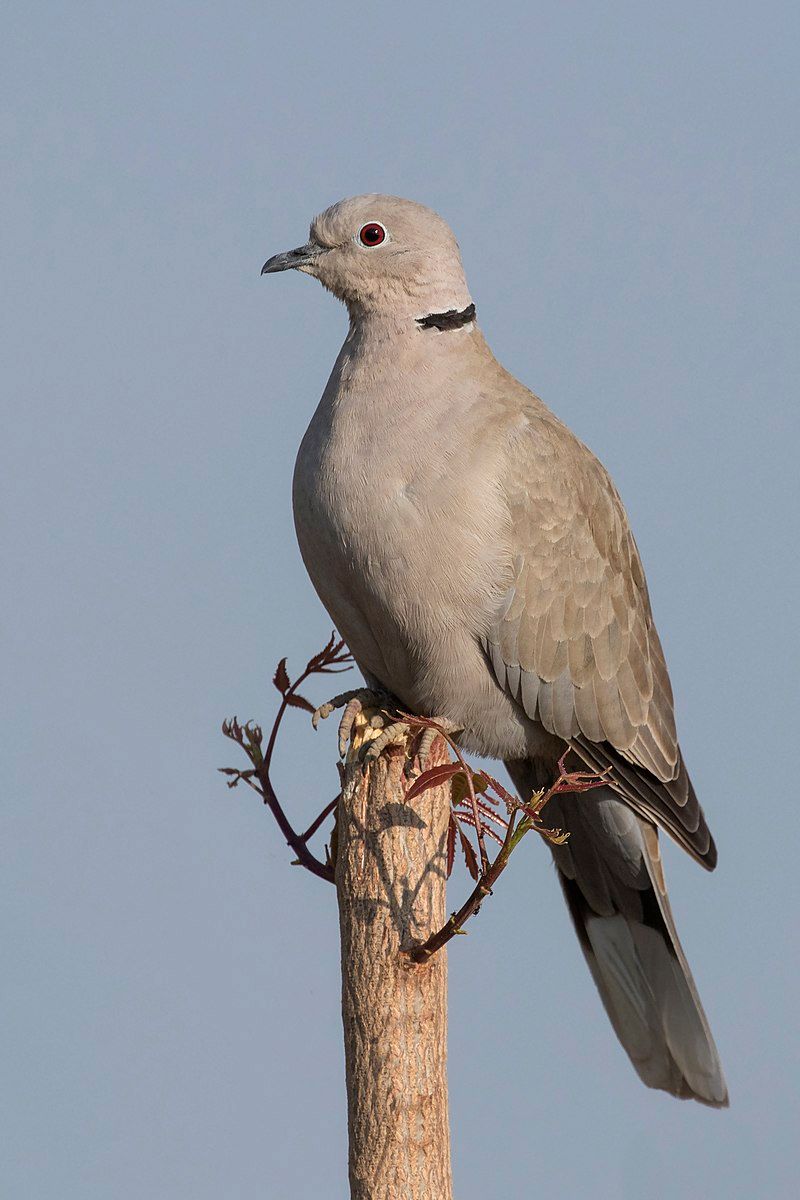
The Eurasian collared dove is a species native to parts of Europe and Asia. It has since been introduced to Japan, North America, and islands in the Caribbean. This species can thrive in various climates, and its population is rising.
As a result, it has been designated as Least Concern on the IUCN Red List since 2014.
This is because its vast global range and population trend indicate that the species is not in immediate danger. The Eurasian collared dove is a medium-sized dove, typically measuring around 30 cm in length.
They tend to have a light gray head and neck, a black collar around the neck, and bright pink feet. The wings are grayish-brown with white tips, while the tail is black with white edges. The species is mainly found in open woodlands, scrublands, and agricultural lands.
It feeds on a variety of different seeds and grains and will occasionally take insects. The Eurasian collared dove is usually found in pairs or small groups in the wild.
They typically nest in trees but occasionally use artificial structures such as telephone poles and buildings. The nest is usually constructed from sticks and lined with grass and other soft materials. The female lays two white eggs, which both parents will help to incubate.
Once the eggs hatch, both parents will take turns feeding the chicks. The Eurasian collared dove is a species that is here to stay. Thanks to its global range and increasing population trend, it has been classified as Least Concern on the IUCN Red List since 2014.
This species is a testament to birds’ resilience and ability to adapt to new environments.
| Kingdom | Animalia |
| Phylum | Chordata |
| Class | Aves |
| Order | Columbiformes |
| Family | Columbidae |
| Genus | Streptopelia |
| Species | S. decaocto |
22. Western Capercaillie
The Western Capercaillie, also known as the Eurasian Capercaillie, Wood Grouse, Heather Cock, Cock-of-the-Woods, or simply Capercaillie, is an impressive member of the grouse family.
It is the largest of all existing grouse species and is considered a hefty bird. The heaviest-known specimen of the Western Capercaillie was recorded in captivity, and it weighed an astonishing 7.2 kilograms.
This makes it one of the heaviest birds that exist in the world today. The Western Capercaillie is quite distinct from other members of the grouse family, mainly due to its size. It has a black-brown head and neck and a grey-brown body.
Its feathers are usually grey-brown, with mottled black and white markings, and it has a long tail that is often decorated with white spots.
The Western Capercaillie also has a distinctive black and white barred pattern on its wings. The Western Capercaillie is an incredibly adaptable species, and it can be found in various habitats, from open woodlands to mountain meadows.
It is a solitary species and can often be found atop trees or rocks or foraging for food on the ground.
The Western Capercaillie feeds on a variety of plants and insects, and it also has a fondness for fruits and seeds. The Western Capercaillie is a fascinating species, and it is no surprise that it is a famous game bird.
It is also an essential part of the forest ecosystem, helping to maintain a healthy balance of predators and prey.
| Kingdom | Animalia |
| Phylum | Chordata |
| Class | Aves |
| Order | Galliformes |
| Family | Phasianidae |
| Genus | Tetrao |
| Species | T. urogallus |
23. Glossy Ibis
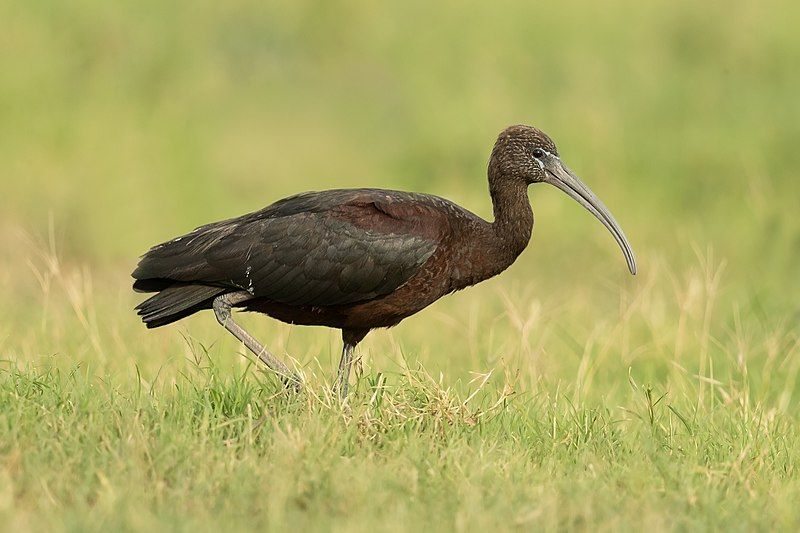
The glossy ibis is a species of water bird belonging to the order Pelecaniformes, which includes pelicans, herons, and storks, and its own family, Threskiornithidae, along with other ibis and spoonbills.
The species is highly recognizable due to its unique bill shape, aptly reflected in its scientific name, derived from Ancient Greek and Latin words meaning “sickle.”
This curved bill allows the bird to efficiently forage for food in shallow waters, such as marshes and ponds, where it mainly feeds on aquatic invertebrates.
The glossy ibis is a widespread species with an extensive range covering much of the world’s tropical and subtropical regions. It is also a highly social bird, often seen in large flocks, and can be observed gathering in large numbers at wetlands.
These gatherings can be quite a sight, as the birds’ plumage is most striking in the sunlight. Overall, the glossy ibis is an impressive species in terms of its physical appearance and ability to adapt and thrive in a wide variety of habitats.
| Kingdom | Animalia |
| Phylum | Chordata |
| Class | Aves |
| Order | Pelecaniformes |
| Family | Threskiornithidae |
| Genus | Plegadis |
| Species | P. falcinellus |
24. Little Ringed Plover
The little ringed plover is a small bird species belonging to the genus Charadrius. The word Charadrius comes from Late Latin and describes a yellowish bird mentioned in the fourth-century Vulgate.
This word ultimately derives from the Ancient Greek word kharadrios, which was used to refer to a bird that could be found in river valleys.
This plover species is usually found in open habitats such as wetlands, grasslands, and shorelines, where it feeds on insects, crustaceans, and mollusks. It is well-adapted to these environments and can be seen running rapidly and flying away when disturbed.
It is a small bird that measures between 15 and 17 cm long and has a wing span of 35 to 40 cm. It has a white belly, a grayish-brown back, and a black head and neck. Its legs are black, and its bill has a yellow base.
The little ringed plover is an essential bird species as it is vulnerable to human disturbance and is listed as a ‘most minor concern’ species on the IUCN Red List.
| Kingdom | Animalia |
| Phylum | Chordata |
| Class | Aves |
| Order | Charadriiformes |
| Family | Charadriidae |
| Genus | Charadrius |
| Species | C. dubius |
Conclusion
The diverse avian population of Sachsen offers a captivating array of species for birdwatchers to observe and appreciate. From majestic raptors like the White-tailed Eagle to the delicate beauty of the Eurasian Blue Tit, each bird contributes to the rich tapestry of Sachsen’s ecosystems.
Through careful conservation efforts and habitat preservation, these birds continue to thrive in their natural habitats, providing endless opportunities for enthusiasts to connect with nature and deepen their understanding of the region’s biodiversity.